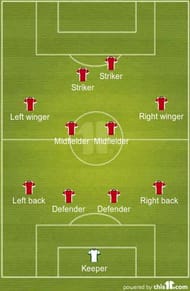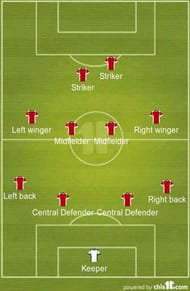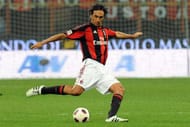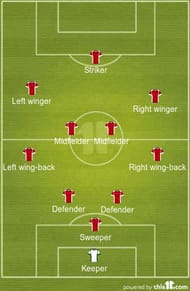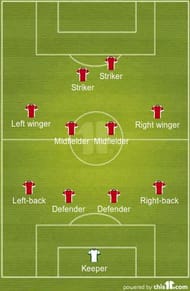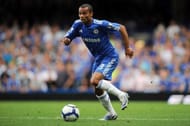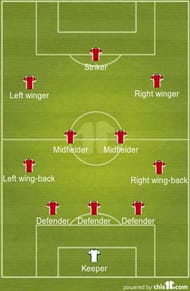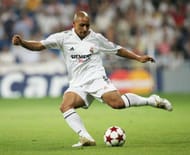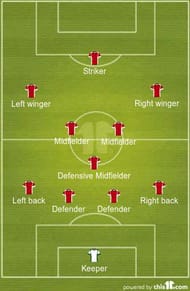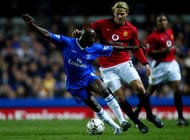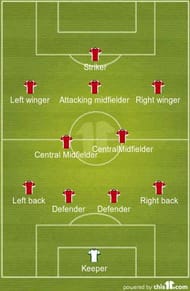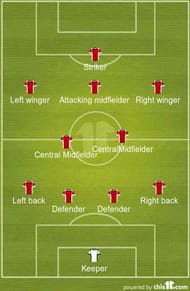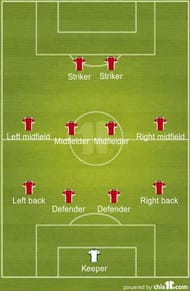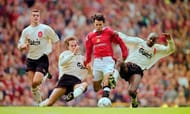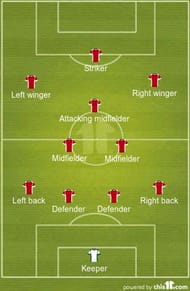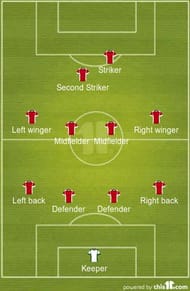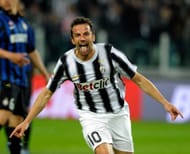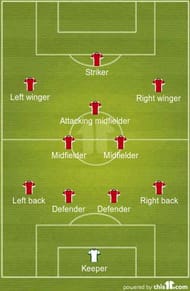Every team sport has different roles for different members of the team. Depending on the size of the playing area and the number of players allowed in the game, the different types of roles vary. In the case of football, the field has a permissible length of 90-120 metres and a permissible width of 45-90 metres. This allows for distinct roles to exist for the players of a team and therefore distinct positions for the different members of a team.
Over the years, the advancements in technology, sports science and nutrition have helped in the evolution of tactical formations, leading to new positions being formed. As long as the sport is played, some positions will keep getting redundant and new positions will be invented and this process will continue.
Broadly, depending on the location on the pitch, the different categories are that of goalkeeping, defence, midfield and attack. The different positions are sub-categories of the aforementioned ones and certain positions even overlap different categories.
So, here are the different positions split according to the broader category that have been used in the sport till date.
Goalkeeping:
Goalkeepers – Regular and Sweeper
Goalkeepers are the only players in football who are legally allowed to use their hands in order to deal with the ball, albeit within the demarcated 18-yards box. The role of a regular goalkeeper is to make saves using any part of his body, deal with high balls, organise his defence, command the box and always maintain a high level of concentration even when he is not being tested.
Their role is tougher than the other ones for even if the goalkeeper makes one mistake, it normally results in a goal because he is the last line of defence. Therefore, they have the chance to save games regularly and even hold the potential to win games in case a cup match ends in a draw and moves on to a penalty shoot-out. Some of the famous such keepers are Lev Yashin, Gianluigi Buffon and Manuel Neuer.
Sweeper keepers are a new generation of keepers where the primary function is same as that of a regular keeper. However, these players have an added ability of being good at passing the ball, thereby involving in general gameplay as well. Their distribution with both their hands and feet in finding team-mates and launching counter-attacks makes them a valuable asset to the side.
However, it is always a risky proposition for a goalkeeper to come out and involve in the flow of the game and one mistake could lead to conceding a goal. But when properly executed, they act as an extra outfield player for the team and can pick up assists for goals as well. These keepers are typically seen standing out of their box in their own half when their team is on the front-foot to provide an outlet for a pass if need be.
Manuel Neuer is the perfect example of a sweeper keeper and Pep Guardiola further emphasised it in the teams he managed so far. In the present scenario, all top teams tend to have one and some of the famous ones are Manchester United’s David de Gea, former Barcelona keeper Victor Valdes and Tottenham captain Hugo Lloris.
Defence:
Centre-back – Regular and Ball-playing
The alternate term for a centre-back, centre-half is no longer applicable in current formations that involve 3 to 5 defenders. In fact, the term centre-half came into existence decades ago when a very attacking 2-3-5 formation was used where the “3” were referred to as the half-backs. As formations evolved, the central player from the “3” moved further back and took the name along as well.
Generally, every team’s formation currently employs two or three centre-backs positioned in front of the goalkeeper and their prime responsibility is to prevent the opposite team’s strikers and attackers from getting inside the penalty box and score goals. As a result, height, strength and positioning are key attributes of a centre-half.
This gives them an advantage in set-piece situations where the aerial capability of the defender can lead to a goal for the attacking team. Some of the famous centre-backs of the past decade include Chelsea’s John Terry, Barcelona’s Carles Puyol and AC Milan’s Alessandro Nesta.
Another variant of centre-backs called the ball-playing centre-backs exist wherein they possess the ability to play forward passes and can make attacking contributions with their feet apart from defending as well. The best practitioners of this art are Barcelona’s Gerard Pique, Bayern Munich’s Mats Hummels and Juventus’ Leonardo Bonucci.
Sweeper
A role that is obsolete in the current scheme of things, the sweeper role or libero (Italian word meaning free) was a key part of the catenaccio system used to great effect in the 1960s in Italy. In this highly defensive system, a libero was positioned closer to the goalkeeper than the centre-backs and was tasked with mopping up loose balls, holding off opposition attacks if the front lines are beaten and help the team out wherever necessary.
However, the entry of the offside rule into football rendered the position pointless as defenders have to stay in line, else they run the risk of allowing the opposition run onside. Bayern Munich and Germany’s Franz Beckenbauer is credited to be the greatest libero of all time.
Full-back – Left and Right
Full-backs is a position that has evolved over decades. Initially, the full-backs were the deepest players, closest to the goalkeeper. However, once the centre-half role was pushed back, the full-backs went wider and became left-back and right-back. They are primarily used in a formation that has 4 defenders at the back with full-backs flanking the two centre-backs in the middle.
As a result, the skill set required have changed from height and strength to pace and excellent reading of the game for it is the job of full-backs to prevent attacks from the wings and to deal with wingers who cross the ball into the penalty box. The natural preference is, therefore, a left-footed player for left-back and a right-footed player for right-back.
In the modern game, the full-back role requires attacking contribution as well in terms of marauding forward and putting in crosses. Some of the best full-backs around are Germany’s Jonas Hector, Barcelona’s Jordi Alba and Bayern Munich’s Philipp Lahm.
Wing-back – Left and Right
A wing-back is effectively an attacking full-back whose attacking ability and threat are just as important as the defending ability if not more. Wing-backs are used in a formation that uses 3 central defenders at the back. The wing-backs are stationed on either side slightly ahead of the defensive line and the term is an amalgamation of “winger” and “full-back.”
As can be understood, this role requires incredible stamina for running up and down the wings. They are tasked with providing width for their team and put in crosses for their forwards to score and how attacking the wing-back is depends on the formation used.
For example, in a 3-5-2 formation, wing-backs position is in the midfield 5 and are therefore much more attacking. On the other hand, in a 5-3-2 formation, the wing-backs are positioned in defence and are therefore more defensive. Real Madrid and Brazil’s Roberto Carlos was one of the best wing-backs ever.
Midfield:
Defensive midfielder – Holding and Deep-lying Playmaker
As the name suggests. a defensive midfielder’s primary role is to intercept oppositions attacks before they reach the defenders. They are stationed centrally in front of the defence and require a combination of high work-rate to constantly snuff out attacks, strength, expert reading of the game and good tackling ability. Generally, a team plays one defensive midfielder and they are also called holding midfielders because they “hold back” when the rest of the midfield joins the attack.
Some of the best players in this role are Claude Makelele for Chelsea and France who owned the role to such an extent that it is now called the “Makelele role”, Barcelona’s Sergio Busquets and N’Golo Kante at Leicester City last season.
A variation of the defensive midfield role exists called the deep-lying playmaker or Regista where the player possesses exceptional vision and range of passing to put cross-field passes for his attack and basically act as a fulcrum for the team’s forward forays. Andrea Pirlo and Bayern Munich’s Xabi Alonso are two of the best players in the role.
Central midfielder
The all-action role in the team, positioned at the centre of the pitch and requiring a combination of defensive and attacking attributes, the central midfield role is the link between the defence and the attack. They receive the ball from the defence and take it along to the attack, either through passes, crosses and even scoring goals when the opportunity arises. Thus, high work-rate, strong tePopularisedlity and immense stamina are required to succeed in the role.
They are generally present in formations that have two central midfielders such as 4-2-3-1 and their defensive ability is just as important as there is no defensive midfielder in this formation. Given the all-round game these players possess, they are also called box-to-box midfielders as they run from their penalty box to the opponents’ for the entire 90 minutes.
Liverpool’s Steven Gerrard, world’s most expensive player Paul Pogba, Real Madrid’s Luka Modric and Manchester City’s Ilkay Gundogan are some of the best players in the position.
Attacking midfielder
The attacking midfielder plays further up the pitch compared to the central midfielders and primarily carry an attacking responsibility. These players are generally the playmakers, the usual custodians of the number 10 jersey and are tasked to create goals using their superior ball control, vision and ability to split open defences with their runs/passes.
Some of the attacking midfielders are adept in scoring goals as well and rack up scoring statistics on par with the forwards along with their assisting numbers making them a complete package.
Another term used for attacking midfielders is Trequartista (in Italian it means three-quarter specialist referring to the position on the pitch) and they are known for their passing range, long-range shooting and dribbling ability. One of the best no.10s of recent decades was Brazil and Barcelona’s Ronaldinho and Real Madrid’s Zinedine Zidane, whose tricks and skills wowed everyone. Some of the famous players in this position are Manchester United’s Henrikh Mkhitaryan, Manchester City’s David Silva, Arsenal’s Mesut Ozil and Real Madrid’s James Rodriguez.
There is another position with roles a mixture of the central midfield and attacking midfield ones, generally used in 4-3-3 or any formation using 3 central midfielders. Here out of the middle “3”, one plays anchor while the other two play higher up the pitch with more emphasis on attack and yet retaining the box-to-box aspect. Some of the current players in this role are Barcelona’s Andres Iniesta and Liverpool’s Adam Lallana.
Wide midfielder – Left and Right
A role that is slowly becoming defunct with the preference for wingers, a wide midfielder is essentially a central or attacking midfielder playing on the sides either due to his pace and dribbling ability or because of their crossing ability. These players normally have good work-rate to contribute defensively as well.
However, with the type of attacking midfielders in 4-3-3 who are positioned wider than a normal midfielder, therefore providing width when necessary and also due to recent tactics preferring wingers who are more attack-minded, the wide midfield role is slowly losing its relevance. Manchester United duo David Beckham and Ryan Giggs were a couple of the finest wide midfielders the game has ever seen.
Forward:
Winger – Left and Right
Currently, most of the best players in the world play in this position and as a result of the devastating impact wingers have, the role has attained supreme importance. Pace is the first key ability of a winger followed by dribbling ability to take on defenders and finally the end-product in terms of goals and assists. Wingers usually hug the touchlines and deliver the ball from there while more technical players can cut in and involve in the play as well.
A new breed of wingers came about in the last decade and they are called the inverted wingers. Popularised by Netherlands and Bayern Munich’s Arjen Robben, these inverted wingers play on the side opposite to that of their preferred shooting foot. For example, Robben plays on the right wing despite being left-footed and vice-versa for the right-footed inverted wingers.
This allows for these players to cut inside from the touchline onto their stronger foot, shifting the marking full-back onto their weaker foot and thereby causing havoc and scoring goals at will. Most of the wingers these days play in the inverted winger position. The current best players in the world, Lionel Messi, Cristiano Ronaldo, Neymar, Eden Hazard, Alexis Sanchez and Gareth Bale all have their preferred position as an inverted winger.
Second striker and Deep-lying Forward
This is another position that is located between the attacking midfielder and striker and is normally used when the attacking midfielder is absent in the formation. This leads to the second striker being involved in the creation part as well apart from scoring.
The position is not a well-defined one with the requirements of good passing skills, vision along with scoring ability similar to that of an attacking midfielder. However, second strikers or deep-lying forwards are strikers first and creators next. Manchester United’s Wayne Rooney in recent years and Juventus legend Alessandro Del Piero are some of the best players in this role.
Centre-forward/Striker
The focal point of the attack, the player tasked with scoring goals to win games, the centre-forward or striker are the most attack-minded players in the team and are stationed closest to the opposition goal. Although this is a single position, different types of strikers exist and correspondingly different attributes. However, the single common skill every type of centre-forward possesses is that of scoring goals.
There are the pacy and agile strikers such as Borussia Dortmund’s Pierre-Emerick Aubameyang who beat defenders using their sheer pace and are very effective in counter-attacking teams. Then, there are the tall, strong target men such as Arsenal’s Olivier Giroud such who allow for a more direct style of play with their ability to win headers and knock-down the ball for his team-mates to pounce upon.
Some strikers such as Manchester City’s Sergio Aguero possess exceptional finishing ability while another breed, albeit a dying one, exists in the form of goal poachers whose key attribute is to score loads of goals in the six-yard box. These strikers are rare these days but Manchester United’s Ruud van Nistelrooy and AC Milan’s Filippo Inzaghi were some of the best players in that role.
Another relatively recent invention is the false-nine position in football. Used sporadically over the years due to different circumstances, this role came into the limelight when Pep Guardiola implemented it at Barcelona with Lionel Messi, a winger having exceptional goalscoring and technical ability, playing as the false-nine. Normally the number 9 is associated with strikers and so false-nine indicates the player is not a striker normally but being played in such a position.
The player plays slightly deeper than the usual striker position and allows for the wingers to cut in, can drop to midfield and thereby pull the defenders along with him leading to spaces opening. A deadly tactic when implemented perfectly but it requires exceptional ability to play the role combining both midfield and attacking skills and hence the rarity of usage.
These are the various positions that have been used in football over the decades. As the game evolves further over the years, we can expect new positions to come into existence while a few of the old positions can become obsolete.
